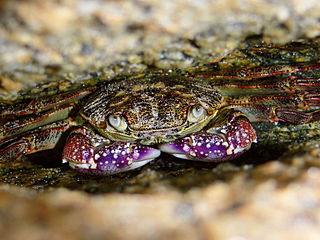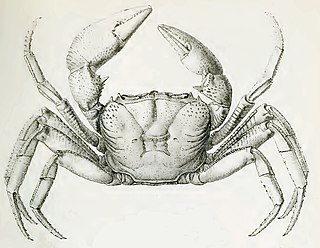
Gecarcinus quadratus, known as the red land crab, whitespot crab, Halloween crab, moon crab, Halloween moon crab, mouthless crab, or harlequin land crab, is a colourful land crab from the family Gecarcinidae.

Leptograpsus variegatus, known as the purple rock crab, is a marine large-eyed crab of the family Grapsidae, found in southern subtropical Indo-Pacific Oceans. It grows to around 50 millimetres (2.0 in) shell width. It is the only species in the genus Leptograpsus.
Hexapus is a genus of crabs in the family Hexapodidae. It contains only three extant species found in the Indo-West Pacific. They inhabit the intertidal and subtidal areas of shorelines.

Heloecius cordiformis is a species of semiterrestrial crab found in mangrove swamps and mudflats along the east coast of Australia. Adults are around 25 mm (1 in) wide, with males being larger and having larger and more conspicuously coloured claws. The males wave their claws to communicate with other crabs, giving them their common name of semaphore crab. They can breathe both in air and under water, and feed at low tide on detritus in the sediment. H. cordiformis is the only species in the genus Heloecius and the family Heloeciidae.

Seychellum alluaudi is a species of freshwater crab endemic to the Seychelles, and the only true freshwater crab in that country. It lives in rainforest streams on the archipelago's granitic high islands. Although it may be abundant, little is known about its biology. If its habitat were to decline in quality, S. alluaudi might become endangered, but it is currently listed as Vulnerable on the IUCN Red List.

Cancrocaeca xenomorpha is a species of troglobitic (cave-dwelling) freshwater crab from Sulawesi, the only species in the monotypic genus Cancrocaeca. It has been described as the world's "most highly cave-adapted species of crab".

Parasesarma leptosoma, also known as the arboreal crab, is an arboreal, leaf-eating mangrove crab, from East and South Africa where it is found on Rhizophora mucronata and Bruguiera gymnorhiza, but not on Avicennia marina. It occupies an ecological niche similar to that of another sesarmid, Aratus pisonii, from the Americas.

Geosesarma dennerle is a species of small land-living crabs found on Java, Indonesia.

Kani maranjandu is a species of tree crab first identified in 2017. K. maranjandu has, to date, only been observed in the forests of the Western Ghats in Kerala, India. As of 2021, it is the only species in the genus Kani.

Nanhaipotamon is a genus of freshwater crabs, in the subfamily Potamiscinae, found in southern China and Taiwan. As of 2018, 18 species have been described. The genus is named after the South China Sea, for it occurs mostly in coastal areas. The genus was first described by R. Bott in 1968 as Isolapotamon (Nanhaipotamon), i.e., a subgenus of Isolapotamon.
Parveen F. Absar is a wildlife biologist from India. In 2017, she was credited with the discovery of a species of freshwater crab called Teretamon absarum, of the genus Teretamon and species speleaum.

Ghatiana is a genus of freshwater crabs, found among the Western Ghats in India.

Limnopilos naiyanetri, commonly referred to as the Thai micro crab or pill-box crab, is a freshwater hymenosomatid crab endemic to Thailand. Its presence has only been confirmed in the Tha Chin River. The species was described in 1991 and represents the type species of Limnopilos. The Thai micro crab was first introduced to the aquarium hobby in 2008 when it was imported to Germany by the tropical fish importer Aquarium Glaser GmbH, and has slowly grown in popularity with aquarium hobbyists. It remains a relatively rare species on the market and detailed information on the husbandry of this species is scarce.
Gubernatoriana triangulus is a species of freshwater crab in the family Gecarcinucidae. The species is endemic to the Western Ghats in India.
Ghatiana pulchra is a species of freshwater crab from the northern Western Ghats in India that was first identified in 2018.

Ghatiana dvivarna is a species of freshwater crab from the Central Western Ghats in India that was first identified in 2022.

Tubuca coarctata is a species of fiddler crab found in the western Pacific ocean, including Japan, Taiwan, the Philippines, Indonesia, New Guinea and Australia. The common name of these crabs is either the compressed fiddler crab, or the orange-clawed fiddler crab,. They are found on tidal mud flats adjacent mangroves and muddy tidal creek and river banks.

Tubuca dussumieri, is a species of fiddler crab that is found in the western and south pacific including New Caledonia, Indonesia, Malaysia, Taiwan, Japan, north eastern Australia

Ghatiana splendida is a species of crab from India, first identified in 2016 in the Western Ghats. Tejas Thackeray, among the discovers of the species, has said that "locals" to where it was first described were aware of the species and would refer to it as the "purple tree crab" or the "pink forest crab". Thackeray first encountered the crab while searching for the olive forest snake.

Barytelphusa cunicularis is a common species of freshwater crab found almost all over India, excluding Northeast India.
















